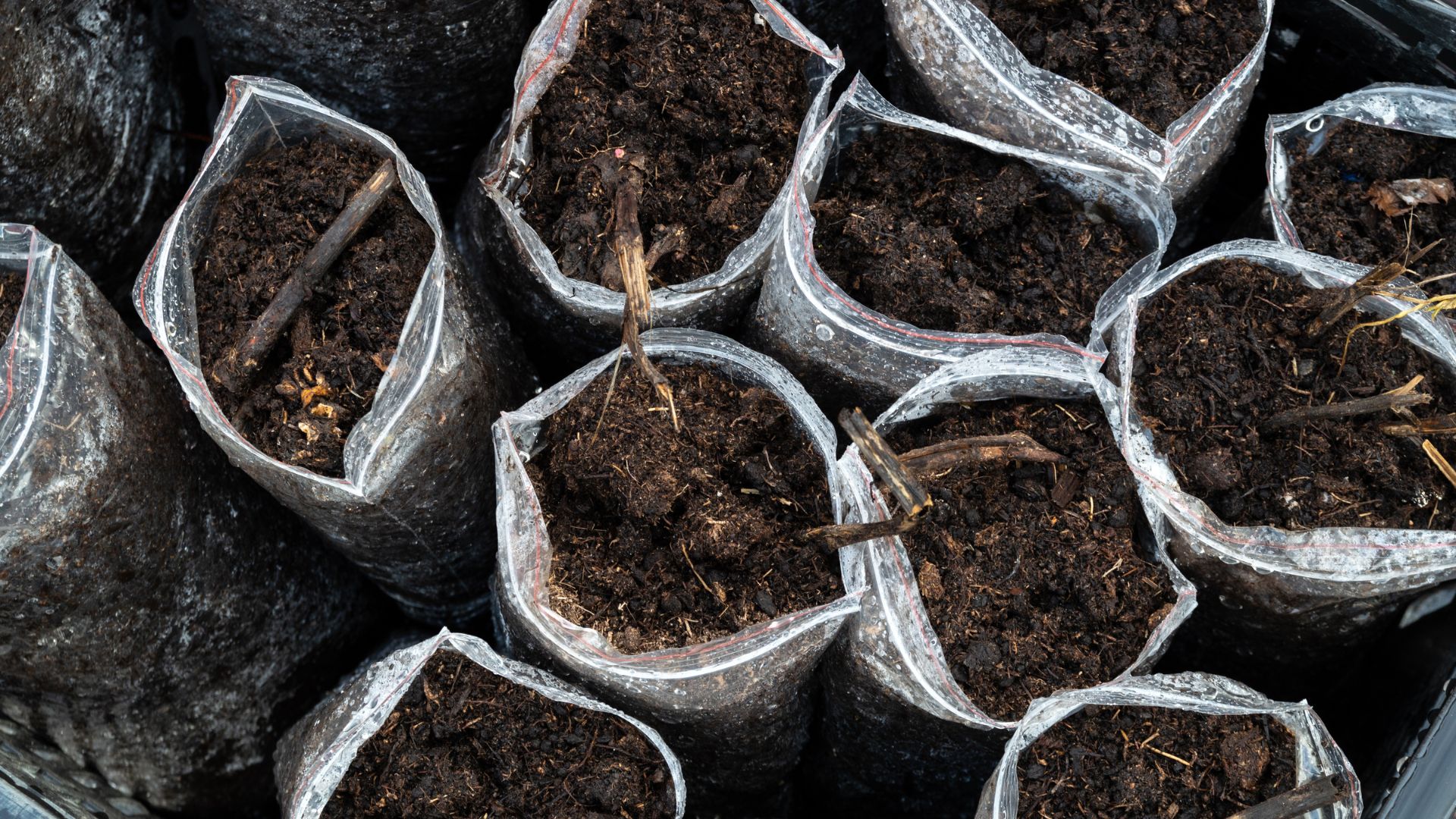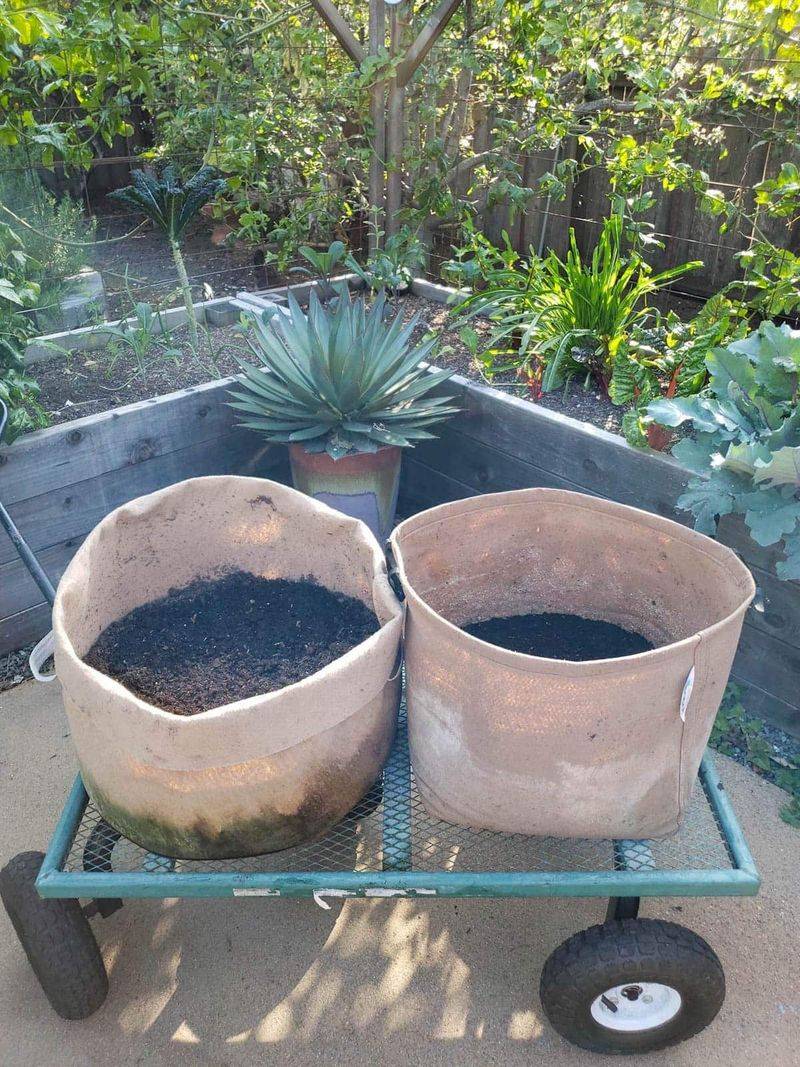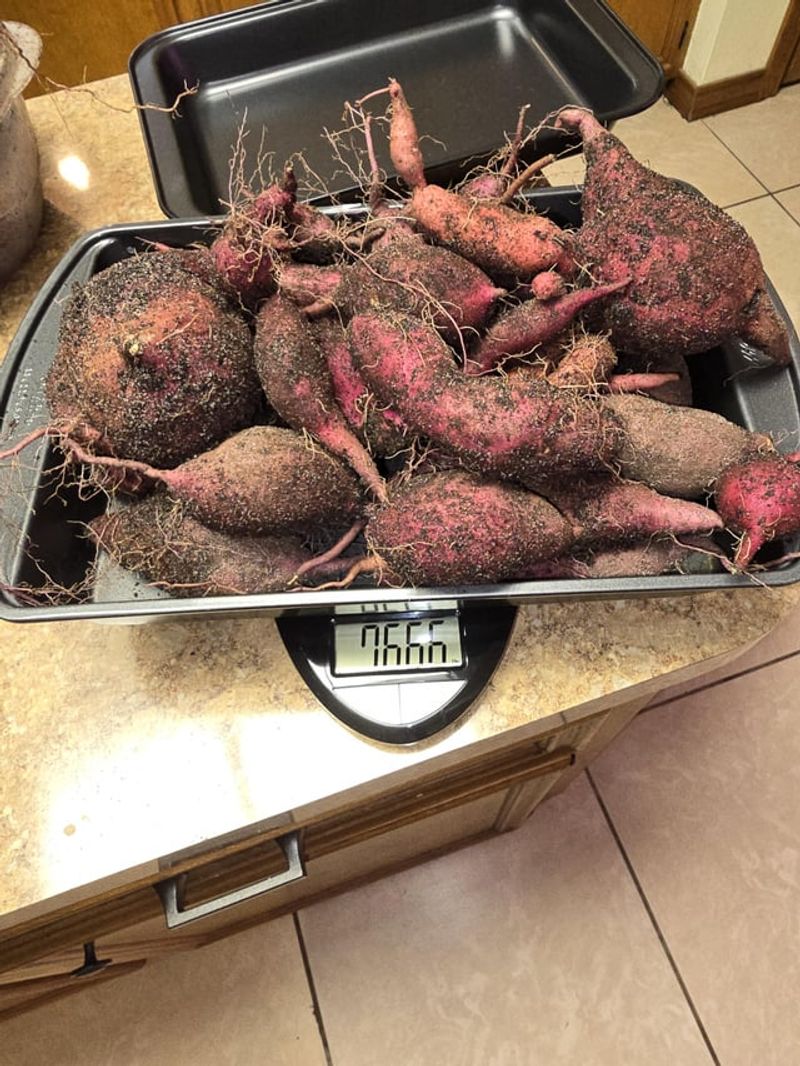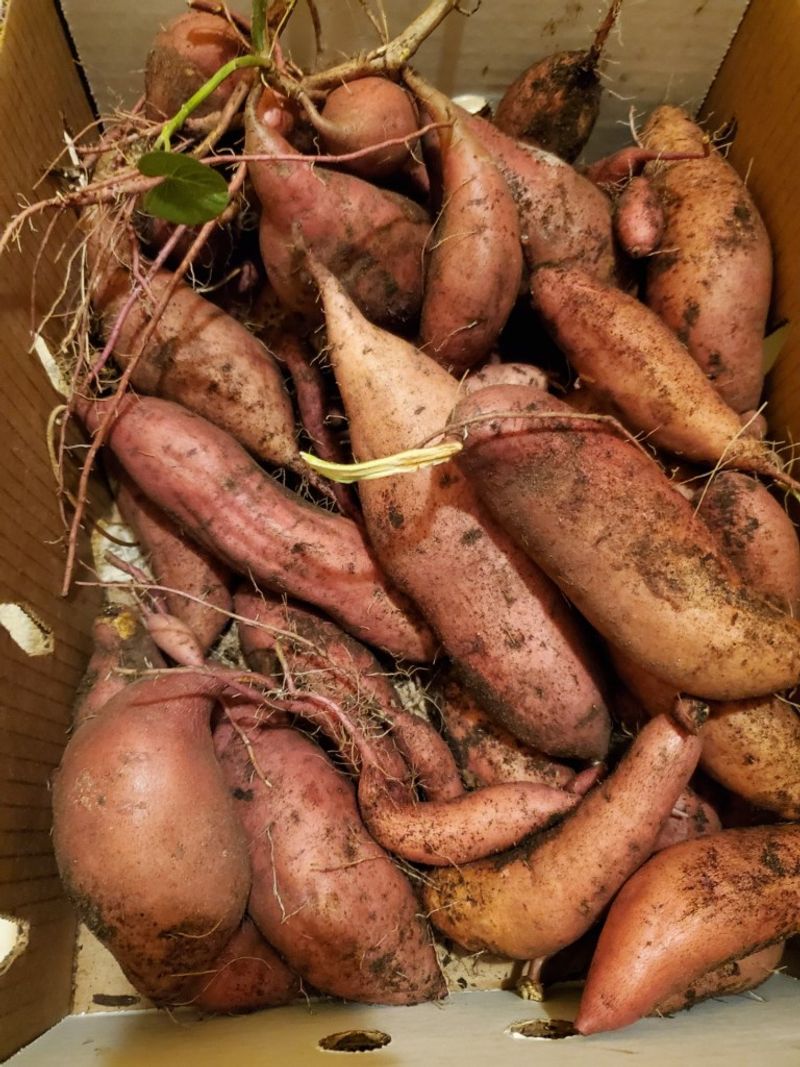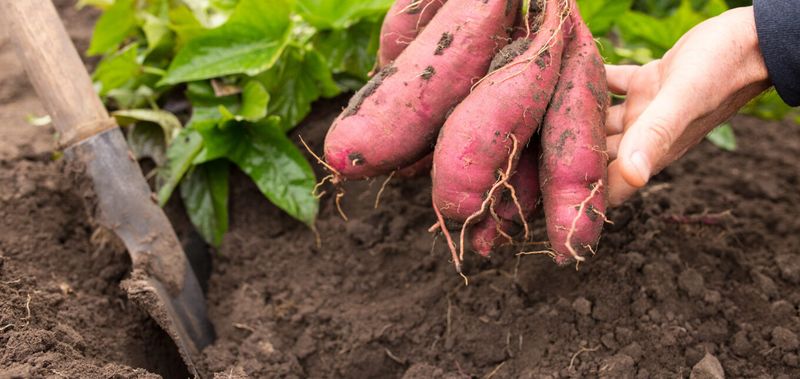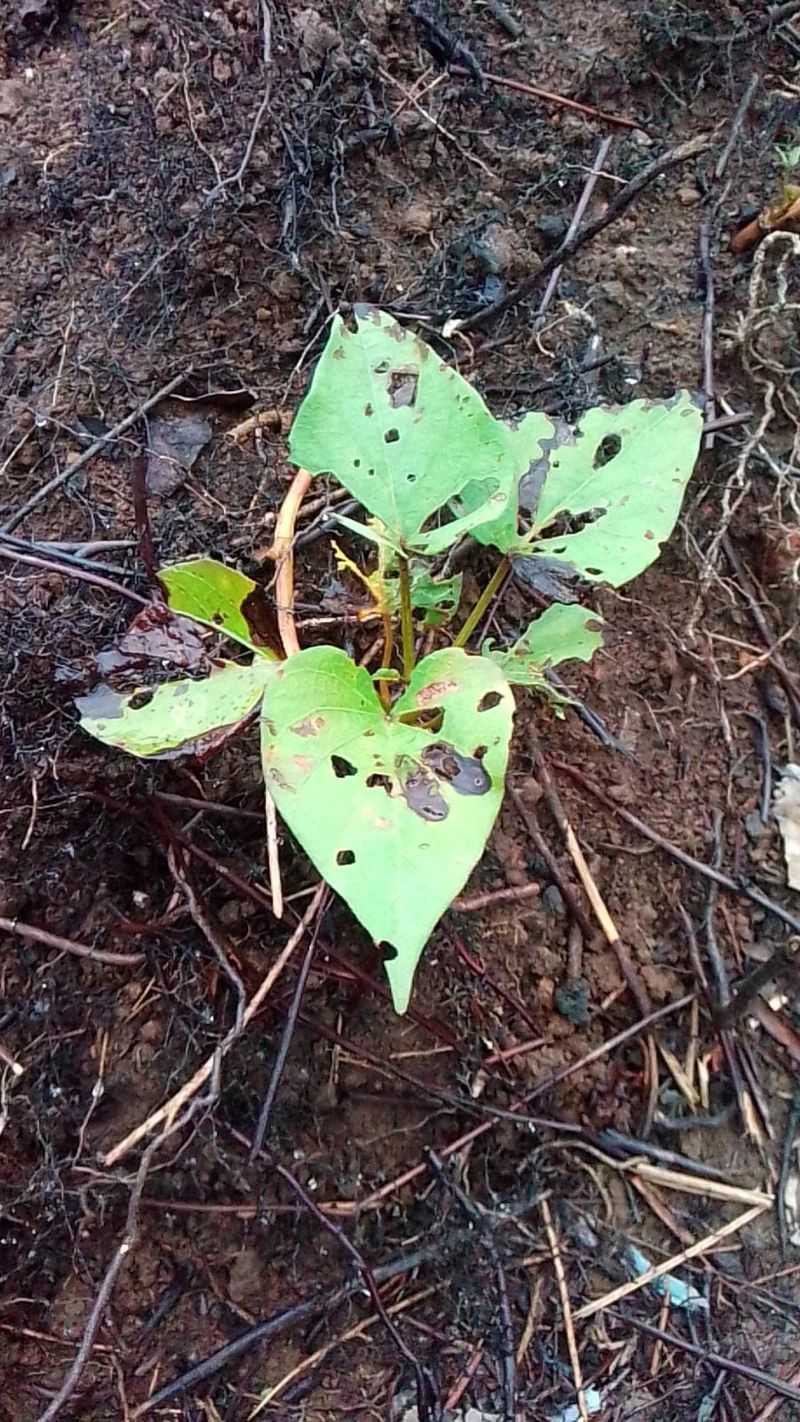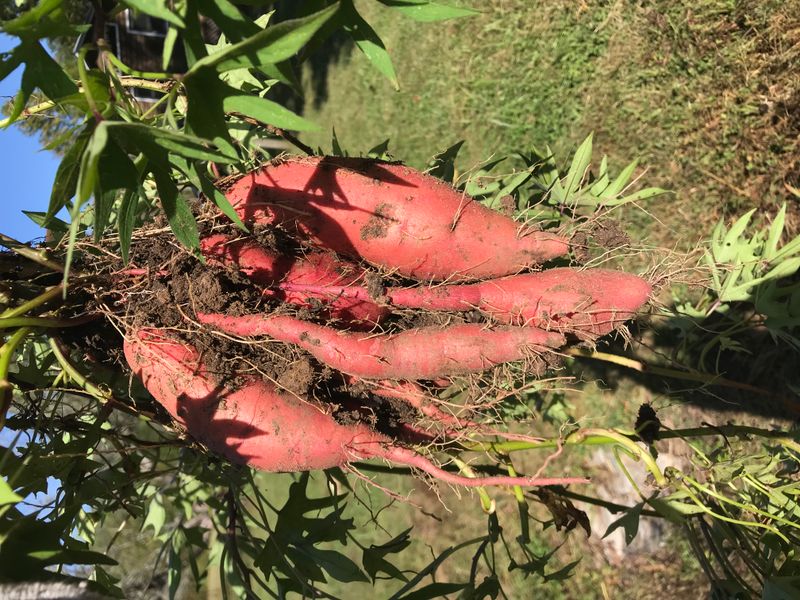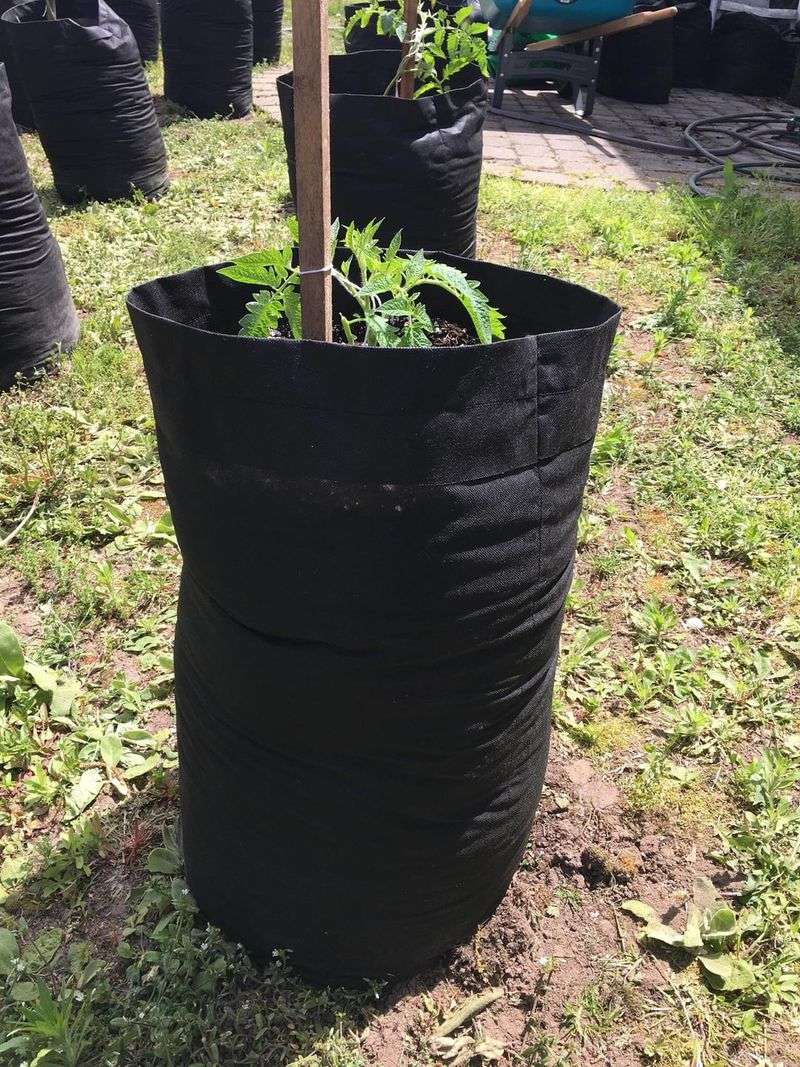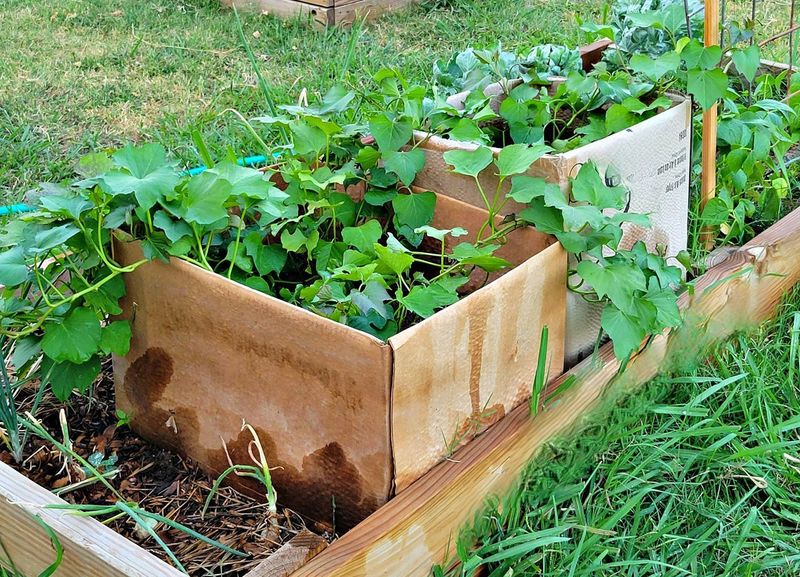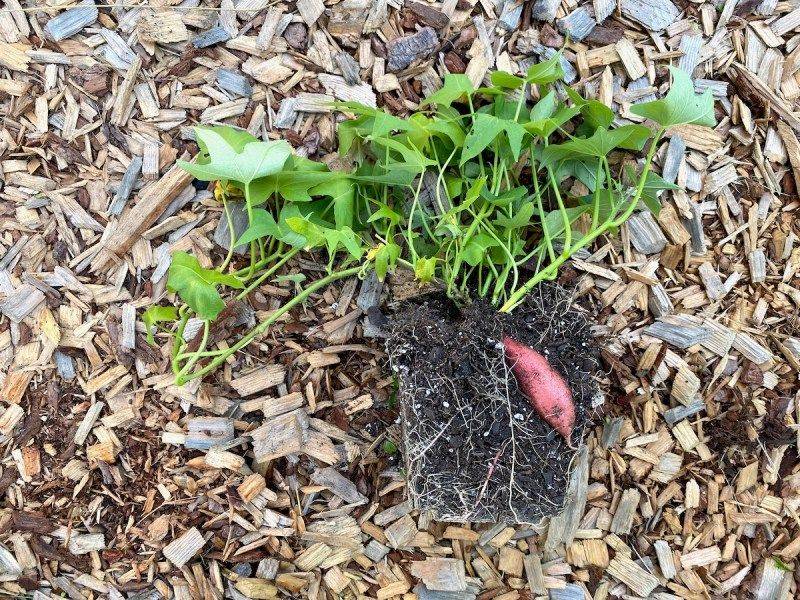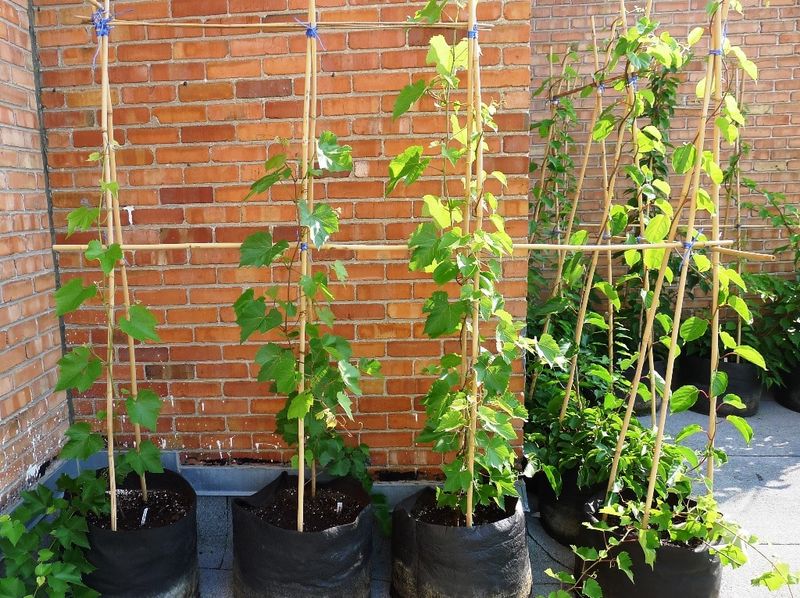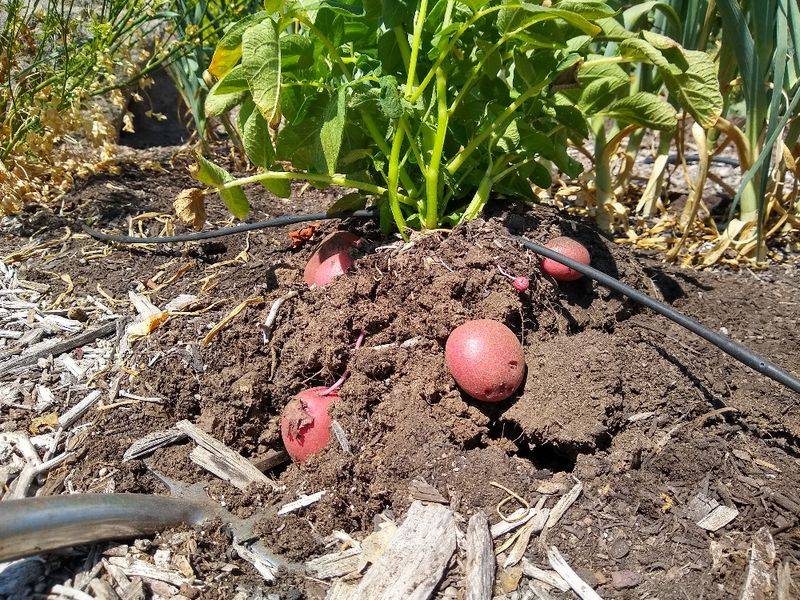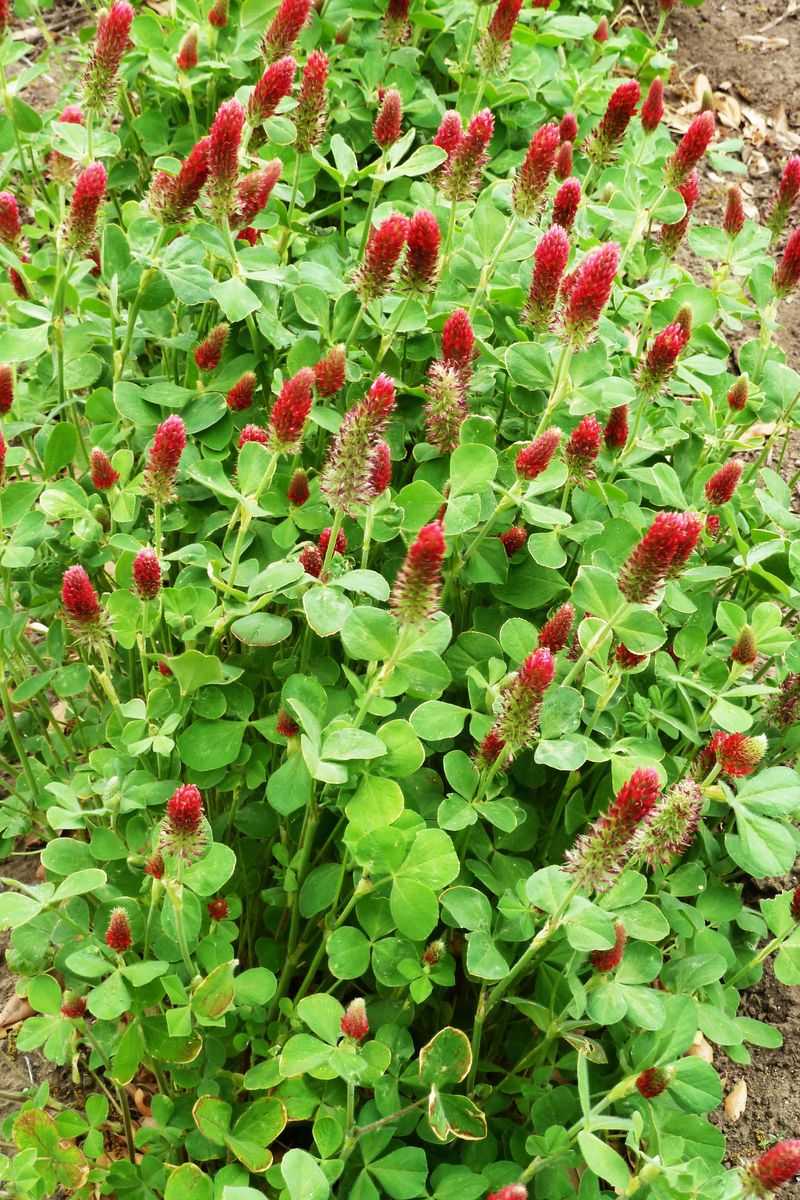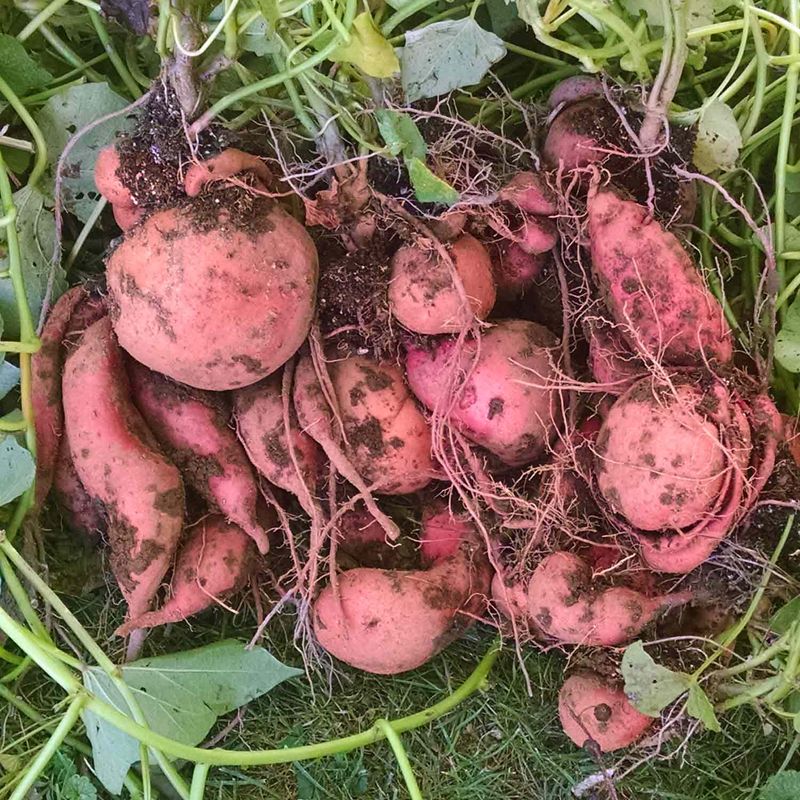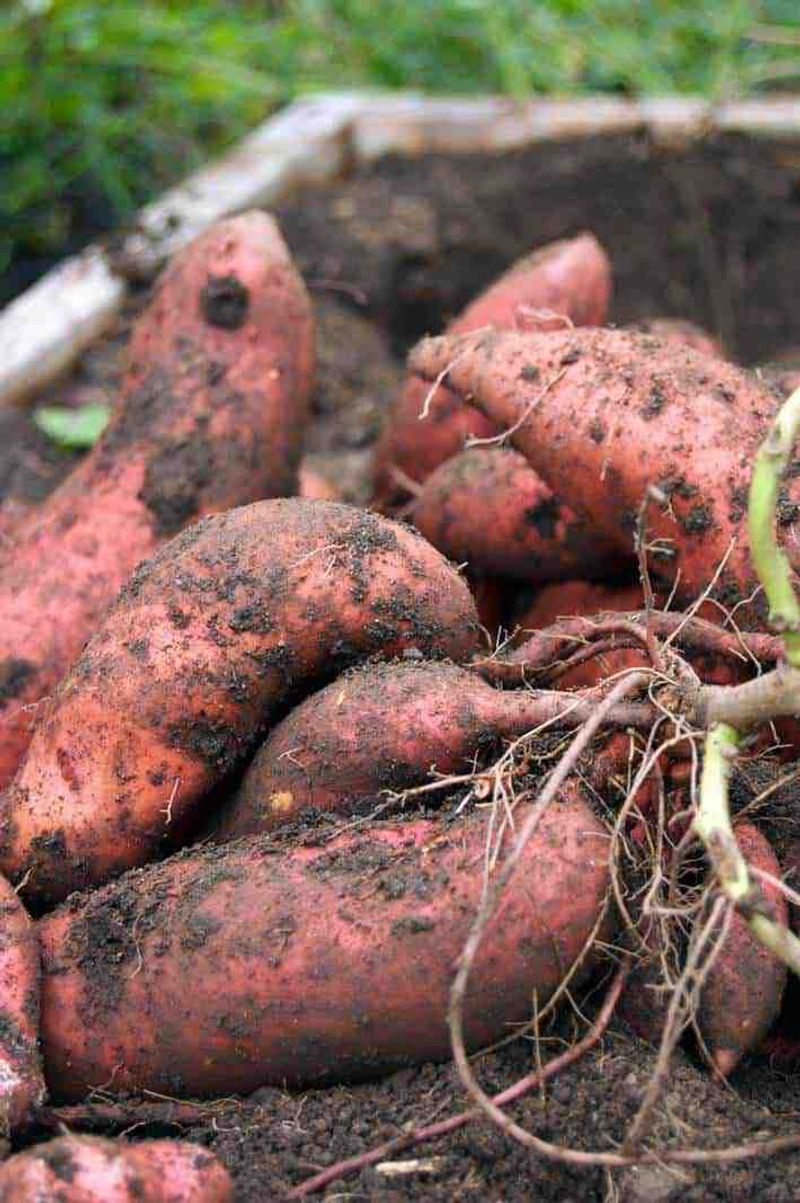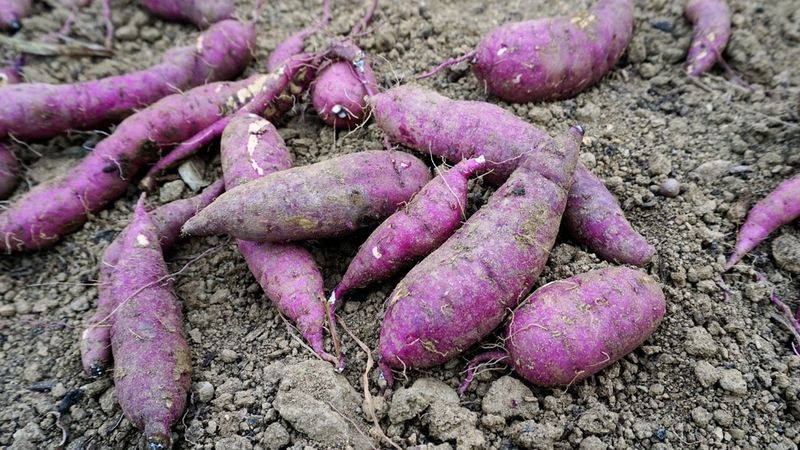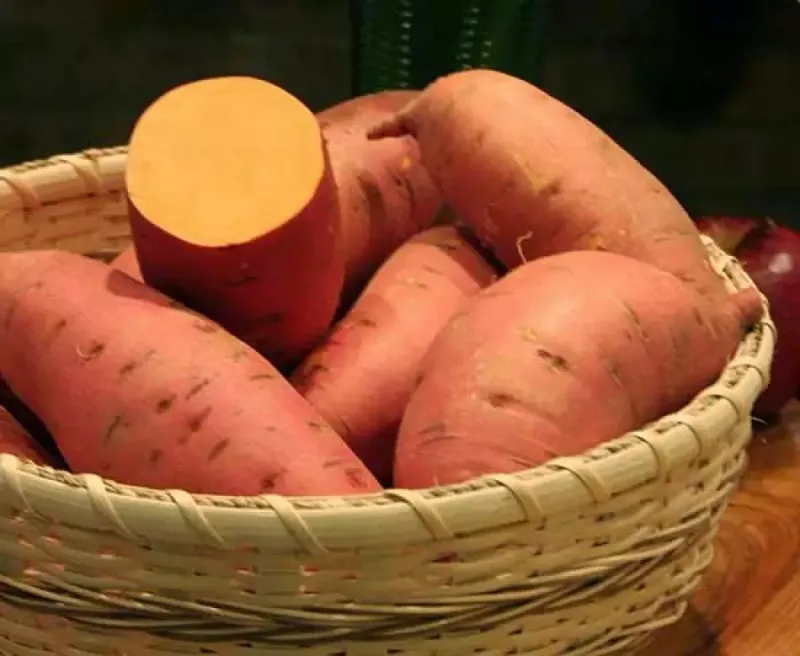Growing sweet potatoes in soil bags turned out to be one of my favorite gardening experiments. I don’t have a ton of space, and my soil is far from ideal, so I figured—why not try growing them in bags? To my surprise, it worked beautifully, and harvesting was as simple as tipping the bag.
The bags provide great drainage and really cut down on pests like wireworms, which used to be a constant headache in my in-ground beds. Plus, it’s easier to manage the soil mix—no guessing what’s going on below the surface.
If you’ve never grown sweet potatoes this way, I highly recommend giving it a try. It’s tidy, low-stress, and the results are impressive—even if you’re working with a small patio or balcony.
1. Horizontal Grow Bag Layering
Laying your soil bag horizontally creates the perfect environment for sweet potato slips to spread their roots. The long, flat surface allows tubers to develop without becoming deformed against container walls. Start by poking drainage holes in the bottom, then cut away the top portion of plastic.
Add a layer of compost on top of the existing soil for extra nutrients that will feed your plants throughout the growing season.
My neighbor tried this method last summer and harvested nearly twice as many sweet potatoes as her in-ground patch. The flat design also makes it easier to check on your potatoes without disturbing the entire root system.
2. Double-Bag Insulation Method
Sweet potatoes love warmth, and using two bags creates a natural insulation layer that keeps soil temperatures ideal. The air pocket between bags provides protection against temperature fluctuations that can slow growth. Place a standard soil bag inside a slightly larger empty bag with drainage holes.
This setup maintains consistent soil temperatures even when nights get cool. The outer bag also offers UV protection, extending the life of your growing setup.
During an unexpected cold snap last season, my double-bagged potatoes continued growing while my single-bagged plants showed stress. This method works especially well for northern gardeners with shorter growing seasons.
3. Vertical Tower Stacking
Maximizing vertical space with stacked soil bags creates a tower perfect for sprawling sweet potato vines. The system allows you to grow more in a tiny footprint while providing excellent drainage through multiple layers. Arrange three to four bags in a pyramid, with drainage holes connecting each layer.
Plant slips in holes cut around the sides as well as the top. The cascading vines not only look beautiful but also shade the bags, keeping soil temperatures consistent.
After trying this method on my apartment balcony, I harvested sweet potatoes from spaces I never thought possible. Just remember to water from the top and let it trickle down through all layers.
4. Sand-Soil Mixture Filling
Adding coarse sand to your growing bags creates the ideal texture for sweet potato development. The sandy mix prevents compaction and allows tubers to expand without fighting against dense soil. Mix garden soil with about 30% coarse sand before filling your bags.
This combination provides excellent drainage while retaining enough moisture to keep plants happy. The loose texture also makes harvesting incredibly easy – sometimes you can just dump out the entire bag.
When I switched to this mixture, my sweet potatoes grew more uniform in shape and size. Sandy soil also warms up faster in spring, giving your plants an early start when temperatures are just beginning to rise.
5. Strategic Drainage Pattern
Creating a specific pattern of drainage holes dramatically improves sweet potato development. Rather than random punctures, a planned approach prevents waterlogging while maintaining necessary moisture levels. Make larger holes (about 1/2 inch) in a grid pattern on the bottom, with smaller holes along the lower sides.
This configuration allows excess water to escape while creating humidity zones inside the bag that sweet potatoes love.
During a particularly rainy month, my strategic-drainage bags thrived while others became waterlogged. The pattern also encourages roots to grow toward moisture gradients, resulting in more extensive root systems and larger tubers.
6. Wicking Bag System
Implementing a wicking system in your soil bags provides consistent moisture that sweet potatoes crave without the danger of overwatering. The setup uses capillary action to draw water up from a reservoir below.
Place a length of rope or fabric through drainage holes, with one end in the soil and the other in a water container beneath the bag. The material pulls water upward as the soil dries out. This self-watering approach is perfect for busy gardeners or during hot spells.
After setting up this system, I noticed my plants survived weekend trips without additional watering. The steady moisture supply also prevented the stress-induced woodiness that sometimes affects sweet potatoes during drought conditions.
7. Black Plastic Heat Absorption
Utilizing black plastic soil bags harnesses solar energy to create the warm soil environment sweet potatoes need to thrive. The dark material absorbs sunlight and transfers heat directly to the growing medium. Position bags in full sun with the black plastic exposed on sides not cut for planting.
During cooler months, this passive heating can raise soil temperatures by 5-10 degrees, significantly extending your growing season in northern regions.
The first time I used this technique, my sweet potatoes matured three weeks earlier than expected. For extra heat retention, place bags on concrete or stone surfaces that also absorb and radiate warmth throughout the day and night.
8. Mulched Top Layer
Adding a natural mulch layer to your soil bags creates multiple benefits for growing sweet potatoes. Straw, leaves, or grass clippings spread over the soil surface regulate temperature and retain crucial moisture. Apply a 2-inch layer after plants are established, keeping the mulch from directly touching stems.
This covering suppresses weeds that compete for nutrients while gradually decomposing to feed your plants. The mulch also prevents soil splashing onto leaves during rain, reducing disease problems.
Last season, my mulched bags required 40% less watering than unmulched ones. The sweet potatoes harvested from these bags had smoother skin too, without the small scars that sometimes develop when tubers are exposed to fluctuating conditions.
9. Slip Angle Planting
Planting sweet potato slips at a 45-degree angle rather than straight down dramatically improves tuber formation in soil bags. This angled approach gives developing potatoes room to expand in the limited bag space. Make holes in your soil at an angle, pointing toward the bag’s center.
This positioning encourages horizontal root growth rather than downward penetration that would hit the bag bottom. The technique works especially well in shallower growing bags that might otherwise limit potato size.
The difference became clear during harvest when I compared angled versus vertical plantings. Angled slips produced more uniform tubers with fewer oddly-shaped potatoes. This simple adjustment requires no extra materials yet significantly improves yield quality.
10. Bamboo Trellis Support
Constructing a simple bamboo trellis above your soil bags transforms how sweet potato vines grow and increases your harvest. The support system keeps foliage off the ground, improving air circulation and photosynthesis efficiency.
Insert bamboo stakes around bag edges, connecting them with string in a grid pattern about 12 inches above the soil. As vines grow, gently guide them onto the trellis. The elevated leaves receive more sunlight while the bag surface stays accessible for watering and checking moisture levels.
Beyond improving yields, this method makes small-space gardening more manageable. My patio setup with trellised bags looked ornamental while producing enough sweet potatoes to share with neighbors. The vertical growth also prevented vines from rooting into nearby containers.
11. Side-Cut Harvesting Windows
Creating harvesting windows along your soil bags allows you to check potato development and selectively harvest without disturbing the entire plant. This innovative approach lets you take what you need while letting smaller tubers continue growing.
Cut several 4-inch flaps on the sides of your bags, keeping them closed with garden clips or pins until harvest time. When you’re ready to check progress, simply open a flap, remove mature potatoes, and close it again to protect remaining roots.
The first time I tried this method, I enjoyed fresh sweet potatoes for weeks longer than usual. Instead of harvesting everything at once, I could take just what I needed for dinner. The plants continued producing, with younger tubers growing larger in the additional time.
12. Companion Plant Integration
Integrating specific companion plants into your sweet potato bags creates a symbiotic growing environment that benefits both crops. Shallow-rooted herbs like thyme and oregano use different soil layers without competing with deeper sweet potato roots.
Plant herbs or leaf lettuce around the edges of your bags, leaving the center for sweet potato slips. These companions shade the soil, reducing water evaporation while their aromatic properties can confuse and repel certain pests that might attack your main crop.
The combination of sweet potatoes and basil in my grow bags last year resulted in exceptional harvests of both. The basil seemed to enhance the sweet potatoes’ flavor, while the sweet potato vines protected basil from harsh afternoon sun, creating a mutually beneficial relationship.
13. Rotating Bag Position
Periodically rotating your soil bags ensures even growth and prevents root binding against the plastic sides. A quarter turn every two weeks creates more uniform tuber development throughout the growing season. Mark one side of each bag to track rotation progress.
This simple habit prevents roots from growing predominantly in one direction and helps distribute moisture more evenly throughout the soil. For containers in partial shade, rotation also ensures all parts of the plant receive adequate sunlight.
The difference became apparent when I harvested bags I’d rotated versus stationary ones. The rotated bags produced sweet potatoes with more consistent sizing and fewer misshapen tubers. This technique requires no special equipment—just a reminder on your gardening calendar.
14. Transparent Bottom Viewing
Creating a viewing window at the bottom of soil bags transforms how you monitor sweet potato development. This clever modification lets you observe root growth without disturbing plants. Before filling, place a clear plastic sheet inside the bottom of your bag, visible through drainage holes.
When you want to check progress, simply lift the bag slightly and look underneath. The transparent layer allows you to monitor root health and tuber formation throughout the growing season. This technique helped me learn the perfect harvest timing for my favorite varieties.
Seeing the actual size of developing tubers removed the guesswork from deciding when to harvest. It’s also become a fascinating educational tool when gardening with my curious nieces and nephews.
15. Constant Soil Mounding
Continuously adding soil throughout the growing season sounds helpful but actually wastes effort when growing sweet potatoes in bags. Unlike regular potatoes, sweet potatoes don’t benefit from being buried deeper as they grow.
Many gardeners mistakenly apply regular potato techniques, spending time regularly adding soil around stems. Sweet potatoes develop from the original slip’s root system, not from buried stems. This extra work doesn’t increase yield and can actually delay harvest by burying the plant too deeply.
I experimented with this method alongside standard techniques and found no improvement in harvest size or quality. The mounded bags actually produced slightly smaller potatoes, likely because the plants devoted energy to growing through the additional soil rather than developing tubers.
16. Frequent Bag Repositioning
Moving soil bags to chase optimal sunlight conditions throughout the day sounds logical but creates more problems than benefits for sweet potatoes. The constant disturbance stresses plants and disrupts the delicate root systems developing inside.
Some gardeners drag heavy bags around patios or yards multiple times daily, believing this maximizes sun exposure. In reality, sweet potatoes prefer consistent conditions. Each move risks tearing roots, compacting soil, and damaging developing tubers pressed against the bag sides.
After tracking growth in stationary versus moved bags, I found the undisturbed plants produced significantly better harvests. Sweet potatoes thrive with at least 6 hours of direct sun, but it’s better to choose one good location initially than to constantly reposition bags chasing perfect conditions.

